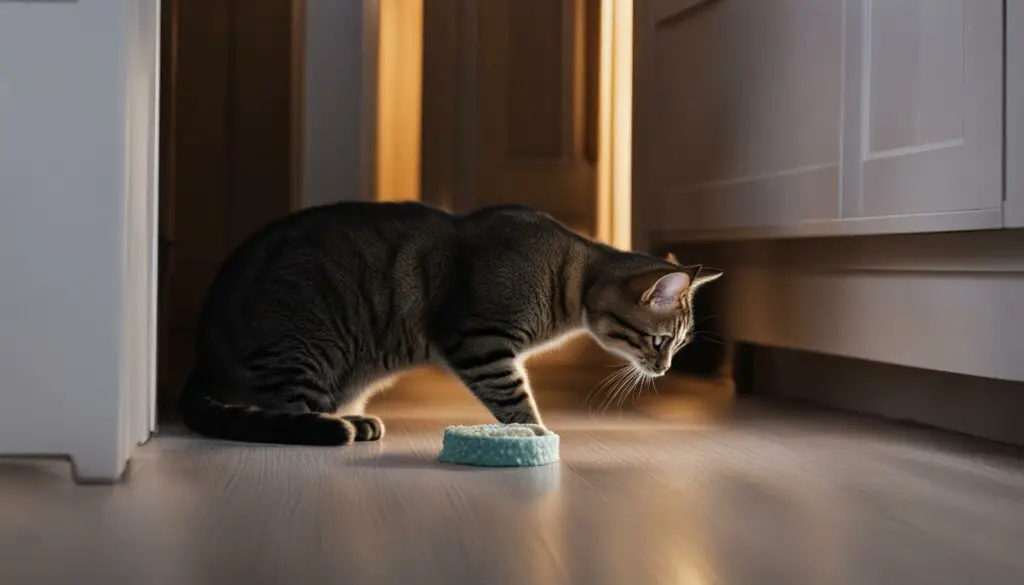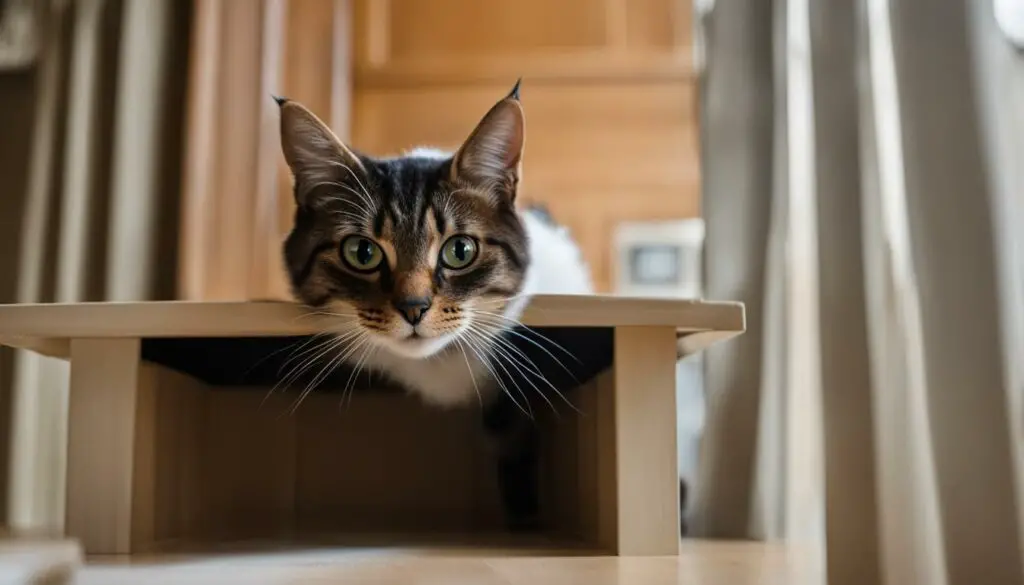Welcome to my guide on coaxing a cat out of hiding! If you’ve ever struggled to lure your furry friend out from their secret hiding spot, you’re not alone. Cats are natural hiders, and understanding their behavior is key to helping them feel more comfortable and socialize. In this article, we’ll explore effective strategies to gently encourage your cat to come out of hiding and build trust. So, let’s get started!
Key Takeaways:
- Cats are natural hiders, and it’s important to understand their hiding behavior and the reasons behind it.
- A gradual approach and patience are essential when coaxing a hiding cat. Avoid rushing or forcing them to come out.
- Create a safe and familiar environment for your cat, providing hiding spots and eliminating any potential hiding triggers.
- Use treats and toys to lure your cat out, gradually building trust and positive associations with coming out of hiding.
- Read your cat’s body language and vocalizations to gauge their comfort level and adjust your approach accordingly.
Understanding Hiding Behavior in Cats
Cats are mysterious creatures with unique hiding habits. Understanding their hiding behavior is essential for helping them feel safe and secure in their environment. Cats may choose to hide when they are scared, stressed, or feeling anxious. It is important to recognize the signs of hiding behavior and address any underlying anxiety they may be experiencing.
Common hiding places for cats include under furniture, beds, in closets, corners, dark spaces, boxes, bags, or behind curtains. These hiding spots provide a sense of security and allow them to observe their surroundings without feeling exposed.
By understanding the reasons behind your cat’s hiding behavior and providing a calm and secure environment, you can help alleviate their anxiety and encourage them to feel more comfortable and confident.

| Hiding Behavior | Causes |
|---|---|
| Under furniture | Feeling threatened or anxious |
| In closets | Seeking a dark and enclosed space |
| Behind curtains | Feeling exposed or wanting privacy |
| In boxes or bags | Exploring and finding a cozy hiding spot |
It is important to create a safe and calm environment for your cat, providing them with hiding spots, vertical spaces, and plenty of mental and physical stimulation. By addressing their hiding behavior and providing them with the support they need, you can help your cat feel more secure and reduce their anxiety.
Gradual Approach and Patience
When it comes to coaxing a hiding cat out, a gradual approach and patience are key. Rushing or forcing the cat to come out of hiding may only cause more stress and anxiety. It’s important to remember that each cat is unique and may require different strategies to feel comfortable.
Start by creating a quiet and safe environment for your cat to feel secure. This can include providing hiding spots such as cozy beds or cat trees in areas where they prefer to hide. These familiar areas will help them feel more at ease and encourage them to come out when they’re ready.
Introduce treats or toys near their hiding spot to entice them out. Start by placing the treats or toys close to their hiding spot and gradually move them further away. This will encourage the cat to explore and associate positive experiences with coming out of hiding.
Be mindful of your actions and avoid sudden movements or loud noises that may startle the cat. Keep in mind that building trust takes time, so be patient and allow your cat to come out on their own terms. This gradual approach will help reduce their anxiety and increase their confidence over time.
| Benefits of a Gradual Approach | Techniques |
|---|---|
| Reduces stress and anxiety | Creating a safe and quiet environment |
| Builds trust and confidence | Introducing treats and toys |
| Encourages exploration and positive experiences | Avoiding sudden movements or loud noises |
Remember, a gradual approach and patience are key when coaxing a hiding cat out. By creating a safe and familiar environment, using treats and toys to entice them, and giving them time and space to come out on their own terms, you can help your cat overcome their hiding behavior and become more comfortable and socialized in their surroundings.
Creating a Safe and Familiar Environment
When it comes to getting a cat to come out of hiding, creating a safe and familiar environment is essential. Cats are naturally cautious creatures, and they feel more at ease in environments that they find familiar. By providing them with a familiar and secure space, you can help alleviate their anxiety and encourage them to come out of hiding.
One way to create a safe environment is to provide hiding spots where your cat can retreat to when they feel overwhelmed. This could be a cozy bed, a cat tree, or even a cardboard box with a blanket inside. These hiding spots give your cat a sense of security and allow them to feel more in control of their surroundings.
Another important aspect of creating a safe and familiar environment is eliminating any potential hiding triggers. Cats are sensitive to changes in their environment, so it’s important to minimize any sudden or loud noises that may startle them. Additionally, removing any unfamiliar scents can help put your cat at ease and make them feel more comfortable coming out of hiding.
| Hiding Triggers | How to Address |
|---|---|
| Loud Noises | Avoid making sudden loud noises around your cat. Provide a calm and quiet environment. |
| Unfamiliar Scents | Remove any unfamiliar scents from your cat’s environment, such as cleaning products or strong perfumes. |
Creating a safe and familiar environment is crucial for helping your cat feel more comfortable and secure. By providing them with hiding spots and addressing any potential hiding triggers, you can encourage them to come out of hiding and gradually build their confidence in their surroundings.
Using Treats and Toys for Luring
When it comes to coaxing a hiding cat out, treats and toys can be invaluable tools. Offering their favorite treats or enticing toys can help to create a positive association with coming out of hiding and make the process more enticing for your feline friend.
To use treats effectively, start by placing them near your cat’s hiding place. As they become more comfortable with the treats being nearby, gradually move them further away, encouraging your cat to venture out and explore. This gradual approach can help build their confidence and trust, making them more willing to come out of hiding.
Similarly, using toys can be a great way to engage your cat and encourage them to come out. Select toys that your cat enjoys and find stimulating. Place them near their hiding spot, enticing them to play and explore. As your cat becomes more comfortable, play with them using the toys, creating a positive and interactive experience that can help build trust and improve their socialization skills.
Remember to be patient and consistent in your efforts, as every cat is unique and may respond differently. Tailor your approach to suit your cat’s preferences and comfort level, and don’t force them to come out if they’re not ready. With time and the right incentives, your hiding cat can gradually learn to embrace their environment.

Understanding Cat Body Language and Vocalizations
When it comes to getting a hiding cat to come out, reading their body language and vocalizations can provide valuable insights into their feelings and comfort level. Cats communicate through a combination of visual cues and vocalizations, which can help you understand their emotions and adjust your approach accordingly.
Body language plays a crucial role in deciphering a hiding cat’s state of mind. Look for signs of fear or anxiety, such as flattened ears, dilated pupils, a low body posture, or a flicking tail. These behaviors indicate that the cat is feeling stressed or threatened. On the other hand, if the cat’s tail is upright and relaxed, and their ears are forward, it signals that they are calm and open to interaction. By paying attention to these visual cues, you can gauge their comfort level and adapt your actions accordingly.
Cats also use vocalizations to express their emotions. Hissing, growling, or excessive vocalization are indications that they are feeling fearful or defensive. Conversely, purring or soft meowing can indicate contentment and a willingness to engage. Understanding these vocal cues can help you determine how comfortable the cat is and adjust your behavior to create a more soothing and reassuring environment for them.

| Body Language | Meaning |
|---|---|
| Flattened ears | Sign of fear or anxiety |
| Dilated pupils | Indication of stress |
| Low body posture | Sign of fear or submission |
| Upright tail and forward ears | Sign of relaxation and comfort |
“Understanding a hiding cat’s body language and vocalizations is crucial in creating a safe and reassuring environment for them. By paying attention to their visual cues and vocalizations, you can adapt your approach to their comfort level and help them feel more secure.”
- Observe the cat’s body posture, ears, and tail position to assess their comfort level.
- Listen to their vocalizations, such as hissing or purring, to gauge their emotions.
- Adjust your behavior and interactions based on their body language and vocal cues to create a more soothing environment.
- Give the cat space and time to feel more comfortable, allowing them to approach you on their own terms.
Remember, each cat is unique, and their body language and vocalizations may vary. By taking the time to understand and respect their communication cues, you can create a positive and supportive environment that encourages a hiding cat to come out and feel more secure.
Bonding and Building Trust
Building a strong bond and trust with your hiding cat is essential for helping them come out of hiding. It requires patience, understanding, and a gentle approach. When you first notice your cat hiding, resist the urge to force them out or invade their safe space. Instead, spend time near their hiding spot, talking softly to them, and offering treats or toys to create positive associations.
Avoid forcing physical contact until your cat is ready. Let them approach you on their own terms. Respect their boundaries and give them space when they need it. By allowing your cat to set the pace, you’re showing them that you can be trusted and that your presence is safe.
Over time, gradually increase your interaction with your hiding cat. Offer daily play sessions using their favorite toys, groom them gently, and engage in interactive activities that they enjoy. This will help strengthen the bond between you and create more positive experiences for your cat, further encouraging them to come out of hiding.
Remember that every cat is unique, and building trust takes time. Be patient and understanding, and don’t get discouraged if progress seems slow. With consistent effort and a gentle approach, you can help your hiding cat feel more comfortable and secure in their surroundings.
| Benefits of Bonding and Building Trust |
|---|
| – Helps your cat feel more secure and confident |
| – Reduces fear and anxiety associated with hiding |
| – Strengthens the bond between you and your cat |
| – Encourages your cat to explore and be more social |
| – Provides opportunities for positive reinforcement and rewards |

Addressing Hiding Triggers and Anxiety
When it comes to coaxing a hiding cat out, it is essential to address the hiding triggers and anxiety that may be causing their behavior. Identifying and minimizing these triggers can help create a more relaxed and secure environment for your feline friend.
Common Hiding Triggers
- Loud Noises: Sudden loud noises such as fireworks or thunderstorms can startle cats and make them retreat into hiding.
- Unfamiliar Scents: Strong or unfamiliar odors in the environment can create a sense of unease for cats, leading them to seek out hiding spots.
- Changes in Routine: Cats are creatures of habit and can become anxious when their daily routines are disrupted or altered.
- Conflict or Aggression: Tension or conflict with other pets or humans in the household can cause cats to retreat and hide for safety.
Reducing Cat Anxiety
To help calm a hiding cat, consider implementing the following strategies:
- Create a Calm Atmosphere: Provide a quiet and peaceful environment by minimizing loud noises and disturbances. Playing soft music or using white noise machines can also help create a soothing atmosphere.
- Use Pheromone Products: Feline pheromone diffusers or sprays emit synthetic versions of natural feline pheromones, which can help reduce anxiety and create a sense of familiarity and security for your cat.
- Offer a Safe Space: Designate a specific area in your home where your cat feels safe and secure. This can be a quiet room or a cozy corner with their bed, toys, and scratching post.
- Consult a Veterinarian or Behaviorist: If your cat’s anxiety persists or worsens, consider seeking professional help. A veterinarian or animal behaviorist can provide valuable insights and guidance to address your cat’s specific needs.
By addressing hiding triggers and reducing cat anxiety, you can create a more comfortable and stress-free environment for your hiding cat. Remember, each cat is unique, and it may take time and patience to find the right approach that works for them.

Solutions for Hiding Prevention
Preventing hiding behavior in cats involves creating a cat-friendly environment that meets their needs. By understanding their natural instincts and providing the right resources, you can reduce hiding behavior and help your cat feel more comfortable and secure.
Cat-Friendly Spaces
To prevent hiding behavior, it’s important to create spaces where your cat can feel safe and secure. Provide plenty of hiding spots, such as cat trees, cozy beds, and boxes. These spaces allow your cat to retreat when they feel the need to hide and can help reduce their stress levels. Additionally, consider offering vertical spaces, such as cat shelves or perches, which give them a sense of security and allow them to observe their surroundings from a higher vantage point.
Interactive Toys and Enrichment
Keeping your cat mentally and physically stimulated is key to preventing hiding behavior. Provide a variety of interactive toys, such as puzzle feeders or treat-dispensing toys, to engage their natural hunting instincts. Set aside regular playtime to bond with your cat and provide them with outlets for their energy. Additionally, consider introducing environmental enrichment, such as scratching posts, climbing structures, and window perches, to keep them entertained and engaged in their surroundings.
Establishing Routines and Consistency
Cats thrive on routine and predictability. Establish a consistent schedule for feeding, playtime, and social interaction. This helps your cat feel secure and reduces their need to hide. Stick to the same feeding times, provide a quiet space for meals, and spend regular quality time with your cat each day. By creating a predictable environment, you can help reduce stress and prevent hiding behavior.
| Cat-Friendly Spaces | Interactive Toys and Enrichment | Establishing Routines and Consistency |
|---|---|---|
| Provide hiding spots, cat trees, and cozy beds | Offer interactive toys and puzzle feeders | Establish a consistent schedule for feeding and playtime |
| Create vertical spaces for your cat to climb | Set aside regular playtime to bond with your cat | Provide a quiet space for meals |
| Consider using boxes or enclosed spaces | Introduce scratching posts and climbing structures | Spend regular quality time with your cat each day |
By implementing these solutions, you can create a cat-friendly environment that reduces hiding behavior and helps your cat feel more comfortable and secure. Remember, each cat is unique, so it’s important to observe their behavior and adjust these strategies to meet their individual needs. With time and patience, you can help your cat become more confident and content in their surroundings.
Dealing with Hiding in New Surroundings
When introducing a cat to new surroundings, it’s common for them to feel scared and overwhelmed, leading to hiding behavior. To help your cat acclimate to their new environment, it’s important to provide them with a quiet and safe space where they can retreat and adjust at their own pace. Gradually introduce them to different areas of the house, allowing them to explore and feel comfortable.

During this transition, it’s crucial to be patient and understanding. Your cat may need some time to adjust and familiarize themselves with the new sights, sounds, and smells. Avoid forcing them out of their hiding spot or putting pressure on them to explore before they are ready to do so.
As your cat begins to feel more comfortable, encourage positive experiences in the new surroundings. Spend time with them in the new space, offering treats, toys, and gentle interaction. This will help them associate the new environment with positive emotions and gradually build their confidence.
In addition to providing a safe and inviting environment, it’s recommended to maintain a consistent routine for your cat in their new surroundings. Stick to regular feeding times, play sessions, and social interactions to create a sense of familiarity and stability. This can help reduce their anxiety and make them feel more secure in their new home.
Addressing Hiding in Stressful Situations
When cats find themselves in stressful situations, their natural response is to hide. As responsible cat owners, it’s important for us to understand how to address this hiding behavior and help our feline friends feel safe and secure. By reducing their stress levels and providing a calm environment, we can encourage them to come out of hiding and feel more at ease.
To begin, it’s crucial to identify the specific triggers causing your cat’s stress. Loud parties, visitors, or changes in routine are common stressors for cats. By creating a calm and quiet space for them during these times, away from the commotion, you can help reduce their anxiety. Consider using pheromone diffusers or playing soothing music to further promote a peaceful atmosphere.
Additionally, providing hiding spots can be beneficial in helping a cat feel secure during times of stress. Cats naturally seek out enclosed spaces when they feel threatened, so offering cozy beds, boxes, or designated hiding areas can give them a sense of safety. Remember to respect their boundaries and avoid forcing physical contact when they’re in these spaces.
By addressing hiding in stressful situations, we can help reduce our cat’s stress levels, contribute to their overall well-being, and strengthen our bond with them. Patience, understanding, and a calm environment are key in calming a hiding cat and helping them feel more secure.
Table: Common Stressors and Calming Techniques
| Stressor | Calming Technique |
|---|---|
| Loud parties or gatherings | Provide a quiet and secluded space for your cat, away from the noise. Use calming sprays or diffusers to create a calm atmosphere. |
| Visitors or unfamiliar people | Allow your cat to have a safe space where they can retreat. Keep them in a separate room or provide hiding spots where they can feel secure. |
| Changes in routine | Stick to a consistent schedule for feeding, playtime, and social interaction to minimize disruptions. Provide familiar items, such as their favorite toys or bedding, to offer comfort. |
By implementing these techniques and ensuring a calm and secure environment, we can effectively address hiding in stressful situations and help our cats feel more relaxed and at ease.

“Creating a calm and quiet space for your cat during stressful situations is essential for helping them feel safe and secure.”
Understanding Hiding in Unfamiliar Territory
When cats find themselves in unfamiliar territory, they may choose to hide as a way to cope with the new environment. Whether it’s a boarding facility, a new outdoor area, or a friend’s house, it’s important to understand their behavior and take steps to help them feel safe and secure.
One effective strategy is to provide familiar items that carry their scent, such as their bed or toys. These objects can provide a sense of comfort and familiarity in an otherwise unfamiliar setting. Additionally, gradually introducing them to the new surroundings and allowing them to explore at their own pace can help ease their transition.
As your cat navigates this unfamiliar territory, it’s important to stay nearby to provide comfort and reassurance. Your presence can serve as a source of security and help them feel more at ease in their new surroundings. With time and patience, your cat will gradually adjust and feel more comfortable in their new environment.

Understanding the Importance of Helping a Cat Feel Safe
Helping a cat feel safe in unfamiliar territory is crucial for their well-being and overall adjustment. Cats are highly sensitive creatures, and a stressful or threatening environment can have a significant impact on their behavior and emotional state.
By taking the time to understand their needs and providing a comforting environment, you can help alleviate their anxiety and facilitate a smoother transition. This may include setting up a quiet and secluded space, providing hiding spots, and ensuring they have access to their favorite toys and familiar scents.
Remember, each cat is unique, and their level of comfort in unfamiliar territory may vary. Be patient, observe their behavior, and adjust your approach accordingly. With your support and understanding, your cat will gradually feel safer and more at home in their new surroundings.
Dealing with Hiding in Small Spaces
When it comes to hiding, cats can be experts at finding the tiniest nooks and crannies to retreat to. It can be frustrating and worrisome when your furry friend disappears into a small space and refuses to come out. However, there are some strategies you can try to encourage your cat to come out of those tight hiding spots.
One effective approach is to create alternative hiding spots that provide a similar sense of comfort and security, but are more accessible to you. Place soft blankets or beds in these areas to make them more inviting. By offering an appealing hiding spot nearby, your cat may be more willing to venture out and explore.
It’s important to avoid forcefully extracting your cat from small spaces, as this can cause them further distress. Instead, try using treats or toys to lure them out gradually. Start by placing the treats or toys near their hiding spot, and as they become more comfortable, move them further away. This positive reinforcement can help build trust and encourage your cat to come out on their own.
Remember, every cat is unique, and what works for one may not work for another. Be patient and understanding, and give your cat the time and space they need to feel safe. With a gentle approach and some enticing alternatives, you can help your cat overcome their preference for small hiding spaces.

| Benefits of Creating Alternative Hiding Spots | Tips for Encouraging a Cat to Come Out of Small Spaces |
|---|---|
| 1. Provides a sense of security | 1. Use treats or toys to lure them out gradually |
| 2. Reduces stress and anxiety | 2. Start by placing treats or toys near their hiding spot |
| 3. Builds trust between you and your cat | 3. Move treats or toys further away as they become more comfortable |
| 4. Encourages exploration and socialization | 4. Avoid forcefully extracting your cat from small spaces |
By applying these strategies and respecting your cat’s boundaries, you can help them feel more comfortable and secure, even in small spaces. Remember, patience and understanding are key when coaxing a hiding cat, and with time, they may choose to venture out on their own terms.
Handling Hiding Under Furniture and Beds
Many cats have a natural instinct to hide under furniture or beds, making it challenging to coax them out. However, with the right approach and a bit of patience, you can encourage your hiding cat to come out into the open. Here are some effective strategies:
Creating a Safe and Inviting Space
When dealing with a cat hiding under furniture or beds, it’s crucial to create a safe and inviting space nearby. Place a soft blanket or bed in a quiet area near their hiding spot. This will provide them with a comfortable alternative while enticing them to come out. Additionally, make sure the space is free from any potential stressors or triggers that might cause them to retreat further.
Using Treats and Toys
Treats and toys can be powerful motivators for coaxing a hiding cat out from under furniture or beds. Start by placing their favorite treats or toys near their hiding spot, gradually moving them further away. This gentle approach will encourage the cat to explore and ultimately come out of their hiding place. Be patient and allow them to approach the treats or toys at their own pace.
Deterrents and Access Points
If possible, create access points that allow your cat to easily exit their hiding spot. This can involve using furniture risers or strategically placing objects to create openings. On the other hand, you can also try using deterrents such as double-sided tape or aluminum foil to discourage them from hiding in specific areas. These tactics can help redirect their attention and encourage them to explore other parts of the room.
Remember, it’s essential to approach your hiding cat with patience and understanding. Avoid forcing them out or using any aggressive methods, as this will only exacerbate their anxiety. With time and a gentle approach, you can encourage them to come out from under furniture or beds and help them feel more comfortable in their environment.
Managing Hiding in Outdoor Areas
Outdoor cats may choose to hide in various areas of the outdoors, such as dense bushes, trees, or even secluded spots like attics and basements. Coaxing them out of hiding requires a gentle and patient approach that respects their boundaries and instills a sense of safety. Here are some tips for managing hiding in outdoor areas:
1. Create a Safe and Inviting Space:
When dealing with an outdoor cat that is hiding, it’s important to create a safe and inviting space near their hiding spot. Place treats or toys that they enjoy in this area to entice them to come out gradually. By making the space comfortable and appealing, you can help them feel more secure and encourage them to explore.
2. Avoid Using Force:
It’s crucial to avoid using force or loud noises to remove an outdoor cat from their hiding place. Doing so may frighten them further, causing them to retreat deeper into hiding. Instead, be patient and allow them to come out at their own pace, using positive reinforcement techniques to build trust and confidence.
3. Provide Shelter and Resources:
Make sure there are adequate shelter options available for the outdoor cat, such as a cozy cat house or a designated spot with comfortable bedding. Additionally, provide a consistent food and water source to encourage them to stay within a specific area. This will help create a sense of security and familiarity, reducing their need to hide.
4. Seek Professional Help if Needed:
If your efforts to coax an outdoor cat out of hiding are not successful or if the cat exhibits signs of extreme fear or anxiety, consider seeking assistance from a professional animal behaviorist. They can provide expert guidance and customized strategies to address the specific needs of the hiding outdoor cat.
Overall, managing hiding in outdoor areas requires patience, understanding, and a gentle approach. By creating a safe and inviting space, avoiding force, providing shelter and resources, and seeking professional help if needed, you can help a hiding outdoor cat feel more secure and gradually come out of hiding.
Conclusion
Coaxing a hiding cat out of their hiding spot can be a challenging task, but with the right approach and a little bit of patience, it is possible to get them to come out. By understanding your cat’s hiding behavior and addressing any underlying anxiety or fear, you can create a safe and familiar environment that encourages them to venture out.
A gradual approach is key when dealing with a hiding cat. Rushing or forcing them to come out will only increase their stress and anxiety. Instead, create a calm and quiet space for them, using treats and toys to entice them out. Let them approach you on their own terms and avoid making sudden movements or loud noises that may scare them further.
Building trust is essential in helping a hiding cat feel more comfortable. Spend time near their hiding spot, offering gentle words and treats. Avoid forcing physical contact until they are ready, and allow them to gradually build confidence in your presence. By creating positive experiences and associations, you can help your cat overcome their hiding behavior and become more socialized.
Remember, each cat is unique, and it may take time for them to feel comfortable enough to come out of hiding. Be patient, understanding, and respectful of their boundaries. With love, care, and persistence, you can help your hiding cat feel safe and secure in their surroundings.
FAQ
What are common hiding spots for cats?
Cats commonly hide under furniture, beds, in closets, corners, dark places, boxes, bags, and behind curtains.
Why do cats hide?
Cats may hide when they are scared, stressed, or feeling anxious.
How do I get a cat to come out of hiding?
To coax a hiding cat out, create a quiet and safe environment, use treats or toys to lure them out, and gradually build trust through positive reinforcement.
How long does it take for a hiding cat to come out?
The time it takes for a hiding cat to come out can vary. It depends on the individual cat and their level of comfort and trust.
What should I do if my cat remains in hiding for a long time?
If your cat continues to hide for an extended period, it may be a sign of underlying anxiety or fear. Consult with a veterinarian or animal behaviorist for additional guidance.
How can I create a safe and familiar environment for my cat?
Provide hiding spots, eliminate potential hiding triggers, and ensure a calm and soothing atmosphere in your home.
What can I use to lure a hiding cat out?
Treats and toys can be effective tools for coaxing a hiding cat out. Use their favorites to entice them to come out of their hiding spot.
How can I build trust with a hiding cat?
Spend time near their hiding spot, talk softly to them, offer treats or toys, and allow them to approach you on their own terms.
How can I reduce a hiding cat’s anxiety?
Reduce potential stressors in the environment, use calming techniques such as pheromone diffusers or calming sprays, and consult with a veterinarian or animal behaviorist for additional guidance.
How can I prevent hiding behavior in cats?
Create a cat-friendly environment with plenty of hiding spots, vertical spaces, and interactive toys. Establish a routine that includes regular playtime, feeding, and social interaction.
How can I help a cat acclimate to a new environment?
Provide a quiet and safe space for them to retreat, gradually introduce them to different areas, and give them time to explore and adjust at their own pace.
How can I calm a hiding cat in stressful situations?
Create a calm and quiet space away from the commotion, use calming techniques such as providing hiding spots or playing soothing music, and give them time to feel secure.
How can I help a cat feel safe in unfamiliar territory?
Provide familiar items that carry their scent, gradually introduce them to the new surroundings, and offer comfort and reassurance until they feel more secure.
How can I encourage a cat to come out of small spaces?
Create alternative hiding spots that provide similar comfort and security but are more accessible. Place soft blankets or beds in these areas to make them more enticing.
How can I get a cat out from under furniture or bed?
Use treats or toys to lure them out gradually, starting near their hiding spot and then moving further away. Avoid using force, as it may cause them more distress.
How can I coax a hiding outdoor cat out?
Create a safe and inviting space near their hiding spot, offering treats or toys that they enjoy. Avoid using force to remove them, as it may frighten them further.
How long does it take for a hiding cat to become more socialized?
The time it takes for a hiding cat to become more socialized varies. It depends on the individual cat and their comfort level. Patience and understanding are key.








